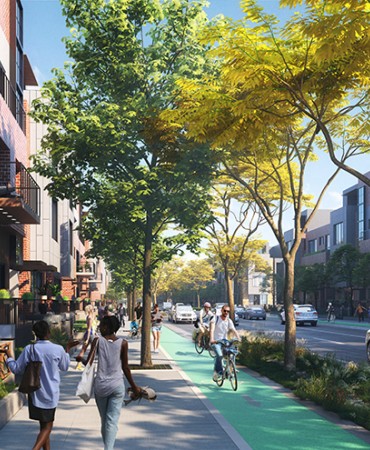Bob Mendes talks East Bank (Video)
When the O’Connell administration took office in late September 2023, it inherited the challenge to encourage smart development around the new football stadium. After months of work, on February 23, 2024, we submitted a proposed Master Developer Agreement between Metro and The Fallon Company for approval by the Metro Council. The 400+ page document outlines how 30-acres around the new football stadium, known as the Initial Development Area, will be developed, what uses will be built there, and who will be responsible for construction and infrastructure costs.
The foundation for the agreement is the Imagine East Bank Vision Plan, which was adopted unanimously by the Metro Planning Commission in October 2022 and was based on two years of deep community engagement. Through the Imagine East Bank Vision Plan, the community asked for the East Bank to include a thriving mixed-income neighborhood.
How is Metro achieving the goal of a neighborhood on the East Bank?
The proposed legislation builds on the vision of an equitable and affordable East Bank with a vibrant, mixed-use, mixed-income community by prioritizing long-term dedicated, high-quality affordable housing. The affordable housing agreements Metro has achieved are unprecedented in Nashville.
To build a neighborhood first requires having neighbors. To accomplish this, our first focus was to require Fallon to deliver 1,550 housing units with a mix of affordability. Fallon will build:
- Within two years of site availability – deliver 300, 100% affordable residential units, together with constructed and reserved space for a day care.
- Within six years of site availability – deliver 400 additional residential units, with at least 10% being affordable.
- Within nine years of site availability – deliver 550 additional residential units, with at least 10% being affordable.
- Once James Robertson Parkway is lowered to grade – deliver an additional 300, 100% affordable residential units, to be jointly developed with an East Bank Transit Center.
Tell me more about the affordable housing requirements.
In an effort to have units at a deeply affordable rate, Fallon will need to utilize a Federal Program known as the Low-Income Housing Tax Credit (LIHTC), which is a tax incentive to construct or rehabilitate affordable rental housing for low-income households.
Before diving further into the breakdown of affordability rates in the proposed legislation, you have to understand what measurement is being used when we talk about affordable housing units. The U.S. Department of Housing and Urban Development (HUD) uses the Area Median Income (AMI) as their metric for programs like LIHTC.
AMI is a metric in affordable housing defined as the midpoint of a specific area’s income distribution. It is calculated on an annual basis by HUD. The federal government defines AMI for Davidson County as a 10-county metro area, including Rutherford County and Williamson County. In 2023, the AMI for all households in this area was listed as $102,500.
Now, back to our proposed development agreement, let’s talk about what levels of affordability Metro is requiring for the East Bank. Fallon has committed that:
- Two-thirds of the units in the all-affordable buildings will be at 60% of AMI and below. Of this housing, Fallon has committed to reserve at least 25% of these units for deeply affordable units for the 30% AMI level.
- The other one-third of units in the all-affordable buildings will be in the 61-80% AMI range.
- In all other residential buildings, where at least 10% of the units will be affordable, those will be at 80% AMI and below.
Having the residential requirements for Fallon include all-affordable buildings ensures that Metro and Fallon will make the most of available federal tax credits to get the highest possible level of affordability on the East Bank.
This is an unprecedented commitment to build a neighborhood with affordable housing.
The most important piece of all of this is the terms at which the units must remain affordable.
The proposed development agreement requires residential affordability to remain in place for the 99-year duration of the leases, ensuring that the East Bank remains an affordable neighborhood for Nashvillians. This is an unprecedented first for affordable housing in Nashville’s history.
While affordability is a key component of achieving the Imagine East Bank vision so are the quality-of-life aspects of the neighborhoods being built.
In the development agreement, Metro has limited the number of hotels permitted within the Initial Development Area. And, later this summer, the administration will offer additional legislation to protect the East Bank neighborhood by expanding the Downtown Code to ensure there are no short-term rentals permitted and no concentrations of bars in the neighborhood.
Metro heard loud and clear from the residents who participated in the Imagine East Bank study that they want this neighborhood to be a place for all of us. The proposed development agreement strives to create a neighborhood where all Nashvillians feel welcome and at home.

